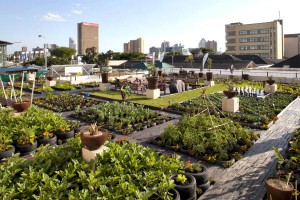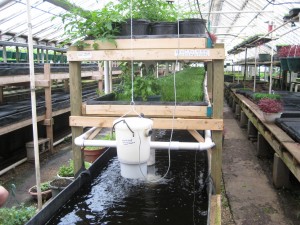Farming in cities? What are you, MAD?
Believe it or not, farming in cities is not only widespread, but has tons of benefit.
Urban agriculture accounts for up to 15% of the world’s food. Japan, The Netherlands, and Chile have more urban than rural farms. Sydney, Australia produced a billion dollars worth of agricultural goods alone, some 12% of the state’s production. In 2014, Detroit produced enough to feed over 600 people for a year, and in 2008, Philadelphia produced 2 million pounds of vegetables.
Urban agriculture doesn’t take one form. A good portion is in the style of community gardens, but greenhouse hydroponics (where plants are suspended in flowing nutrient-rich water), ZFarming (where gardens are structured into building surfaces, vertically even!) and street-side fruit trees are examples of other urban farming practices. Traditional farms don’t work too well in cities because they require big areas, which, within a city, is expensive and difficult to come by. The land price and economies of scale also makes them uncompetitive compared to rural farmers, who can undercut them in price. Within high-end niche markets, however, phrases like city-grown have people willing to buy at a premium, and many inner-city hydroponic and rooftop operations cater to them.
 Rooftop garden, a form of ZFarming
Rooftop garden, a form of ZFarming
No matter which method they take, urban agriculture has a multitude of benefits over importing food. The first category is in reducing environmental impact. The average food import travels 2000 km between its point of production and its point of consumption, contributing significantly to greenhouse gas emissions. The reduction city-grown food makes to this mileage and emission is tremendous, and on top of that there are cuts to cold storage energy use and not-lost product (product that perishes in the ride over, which is a complete waste of resources).
More environmental benefits include decreasing habitat loss from farm expansion and aquaponics (where fish are grown with plants in an enclosed and fully-functioning micro-environment) reduces stress on water ecosystems. Unlike rural farms, urban farms can and many do use graywater systems (already used water, such as from the tub or dishwasher) and recycle it over and over, or just collect runoff. This results in huge water savings, reduces city waste, and prevents erosion and stormwater runoff. Composting on many scales is also used in urban agriculture, yet again reducing city waste export, instead of filling landfills it makes food! If that weren’t enough, urban agriculture has also been shown to reduce city heat-island effects and improve air quality.
There are also numerous social benefits, especially from the not-for-profit oriented urban agriculture projects, such as community gardens and street-side horticulture. These projects usually replace dilapidated vacant lots or brighten gray streets, increasing the overall appeal of neighborhoods and getting people outside more often. This in turn often decreases crime. Also nothing builds a sense of community like dirt and team sweat, and many community gardens distribute food to neighbors and food banks, helping reduce food insecurity and freeing up their money to be used on other essentials.
Clearly, health is also a major category. City grown food will be fresher, and much of the lower class does not get enough food, especially in fruits and vegetables, so diets will be improved and bodies invigorated. It also provides a place for stress relief.
Some pure economic benefit is in the reduction of imports, which keeps money circulating within the city. Many forms create jobs. Housing prices also go up, due to the aesthetic improvements, crime reductions and whatnot, similar to parks but requiring far less area to produce the same effect.
This is not to say the other benefits don’t translate into economic benefits, far from it! Environmental benefits mean long term savings by protecting the deterioration of environmental services, which would cost inordinate amounts of money to replace. Health benefits translate into a more capable workforce. Social benefits do to, and a more communal neighborhood increases stability to changes in economic fortune.
In (not so) short, urban agriculture is surprisingly beneficial. Tacoma has realized this, and is going nuts trying to have the most community gardens per capita. I believe every city should follow suit!
(I found this out while honing in on my thesis topic, so please excuse the lack of links, the info’s from journal articles)


Great article, Nikki. As a site coordinator for my P-patch in Seattle, I’m a big fan of urban agriculture. However, it’s something we do to build community and connections to our food, not to reduce our carbon footprint. Transportation is a generally a small part of the overall carbon footprint of food and, sadly, empirical studies find that local food typically has a larger carbon footprint than industrial food when accounting for all the other aspects of production. Food requires less energy to produce when it is grown in the climate to which it is best adapted. So, we’re back to that old economic principle of trade-offs.
Keep of the great writing!